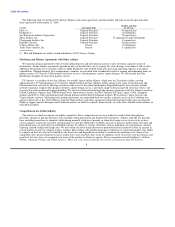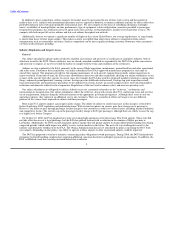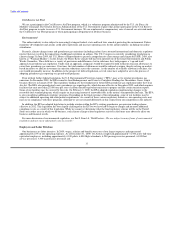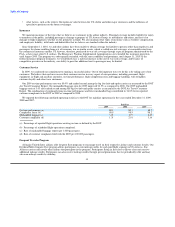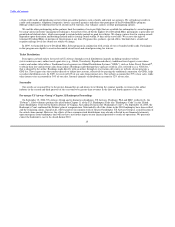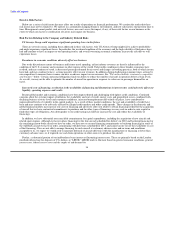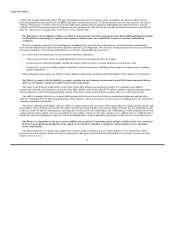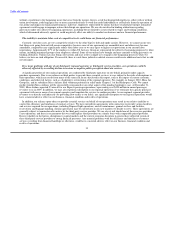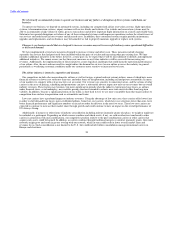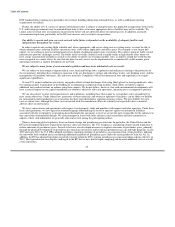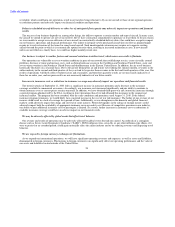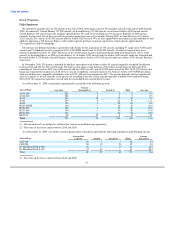US Airways 2009 Annual Report Download - page 20
Download and view the complete annual report
Please find page 20 of the 2009 US Airways annual report below. You can navigate through the pages in the report by either clicking on the pages listed below, or by using the keyword search tool below to find specific information within the annual report.
Table of Contents
Because of the amount of fuel needed to operate our airline, even a relatively small increase in the price of fuel can have a significant
adverse aggregate effect on our costs and liquidity. Due to the competitive nature of the airline industry and unpredictability of the
market, we can offer no assurance that we may be able to increase our fares, impose fuel surcharges or otherwise increase revenues
sufficiently to offset fuel price increases.
Although we are currently able to obtain adequate supplies of aircraft fuel, we cannot predict the future availability, price volatility or
cost of aircraft fuel. Natural disasters, political disruptions or wars involving oil-producing countries, changes in fuel-related
governmental policy, the strength of the U.S. dollar against foreign currencies, speculation in the energy futures markets, changes in
aircraft fuel production capacity, environmental concerns and other unpredictable events may result in fuel supply shortages, additional
fuel price volatility and cost increases in the future.
Historically, from time to time, we have entered into hedging arrangements designed to protect against rising fuel costs. Since the third
quarter of 2008, we have not entered into any new fuel hedging transactions and, as of December 31, 2009, we had no remaining
outstanding fuel hedging contracts. Our ability to hedge in the future may be limited, particularly if our financial condition provides
insufficient liquidity to meet counterparty collateral requirements. Our future fuel hedging arrangements, if any, may not completely
protect us against price increases and may be limited in both volume of fuel and duration. Also, a rapid decline in the price of fuel can
adversely impact our short-term liquidity as our hedge counterparties require that we post collateral in the form of cash or letters of credit
when the projected future market price of fuel drops below the strike price. See also the discussion in Part II, Item 7A, "Quantitative and
Qualitative Disclosures About Market Risk."
If our financial condition worsens, provisions in our credit card processing and other commercial agreements may adversely affect
our liquidity.
We have agreements with companies that process customer credit card transactions for the sale of air travel and other services. These
agreements allow these processing companies, under certain conditions, to hold an amount of our cash (referred to as a "holdback") equal
to a portion of advance ticket sales that have been processed by that company, but for which we have not yet provided the air
transportation. These holdback requirements can be modified at the discretion of the processing companies upon the occurrence of
specific events, including material adverse changes in our financial condition. An increase in the current holdback balances to higher
percentages up to and including 100% of relevant advanced ticket sales could materially reduce our liquidity. Likewise, other of our
commercial agreements contain provisions that allow other entities to impose less favorable terms, including the acceleration of amounts
due, in the event of material adverse changes in our financial condition.
Union disputes, employee strikes and other labor-related disruptions may adversely affect our operations.
Relations between air carriers and labor unions in the United States are governed by the RLA. Under the RLA, collective bargaining
agreements generally contain "amendable dates" rather than expiration dates, and the RLA requires that a carrier maintain the existing
terms and conditions of employment following the amendable date through a multi-stage and usually lengthy series of bargaining
processes overseen by the NMB.
If no agreement is reached during direct negotiations between the parties, either party may request the NMB to appoint a federal
mediator. The RLA prescribes no timetable for the direct negotiation and mediation processes, and it is not unusual for those processes to
last for many months or even several years. If no agreement is reached in mediation, the NMB in its discretion may declare that an
impasse exists and proffer binding arbitration to the parties. Either party may decline to submit to arbitration, and if arbitration is rejected
by either party, a 30-day "cooling off" period commences. During or after that period, a Presidential Emergency Board ("PEB") may be
established, which examines the parties' positions and recommends a solution. The PEB process lasts for 30 days and is followed by
another 30-day "cooling off" period. At the end of a "cooling off" period, unless an agreement is reached or action is taken by Congress,
the labor organization may exercise "self-help," such as a strike, which could adversely affect our ability to conduct our business and our
financial performance.
Additionally, these processes do not apply to our current and ongoing negotiations for post-merger integrated labor agreements, and
this means unions may not lawfully engage in concerted refusals to work, such as strikes, slow-downs, sick-outs or other similar activity,
against us. Nonetheless, after more than four years of negotiations
18


